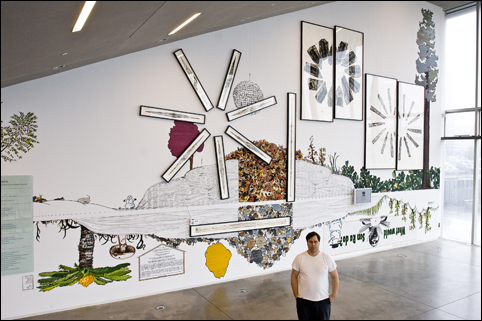
AS BELOW, SO ABOVE: Muller doesn’t get very far beyond the fun premise of a music geek’s High
Fidelity list game. |
Last December 10, the Institute of Contemporary Art moved from a cramped former police station in the Back Bay to brand new digs on the South Boston waterfront, tripling its exhibition space in the process. For many, the glass-and-steel building — designed by the buzzed-about New York firm of Diller Scofidio + Renfro, with its dramatic harbor views and cantilevered top floor reaching 80 feet out toward the water’s edge — lived up to the museum’s advertising slogans: “Breathtaking, sublime, fearless, audacious.” It was a big, bold, $51 million move that dared the museum and the entire Boston art scene to live up to it.
Two new exhibitions — “Momentum 9: Kader Attia” on the fourth floor and “Dave Muller: As Below, So Above” on the lobby art wall — mark the end of the new ICA’s first year and the first full cycle of all the building’s galleries. And they don’t live up to this challenge.

For Kader Attia’s first US solo show, which was organized by ICA chief curator Nicholas Baume, the French-Algerian artist turns a gallery into a dreary spartan dormitory crammed with 24 plywood beds topped by foam mattresses. Bare lightbulbs hang from the ceiling, dimly lighting the room. The scene reflects his childhood in an émigré family in suburban Paris, where five kids would sleep in a room, apparently on makeshift beds similar to these. The untitled installation resembles an orphanage, a prison, or a concentration camp. The imprints of absent bodies are gouged out of the mattresses, recalling the excavated remains of volcano victims, or outlines drawn at crime scenes. These analogies sound rich, but in person the show feels like bad poetry: heavy-handed, forced, simplistic.
Assistant curator Jen Mergel organized the Muller exhibition. The Los Angeles artist and DJ has painted a time line of rock stars across the middle of the big wall and then added trees, rocks, hills, leaves, and snowmen sprouting above and below it. The effect is that of an archæological cross-section. Atop the wall painting, he’s hung framed realist paintings, arranged like pinwheels or stars, of faux aged newspaper-arts-section headings. A DIY radio station broadcasts tunes from Muller’s collection of 20,000 albums (catalogued in a 1418-page book visitors can flip through) to three radios in the lobby.
The music chart is appropriated from the book Rock ’n’ Roll Is Here To Pay: The History and Politics of the Music Industry, a ’70s social history of rock by Steve Chapple and Reebee Garofalo that critiqued its commercialism and noted the buried African-American roots of many white hits. Muller adds music since the ’70s, written backward and in a declining slope to suggest, it would seem, the decline and backward-looking slant of music since. It can be fun to play these music-geek High Fidelity list games, but he adds little besides moving them into the hoity-toity confines of the museum. Unlabeled arrows running below the time line appear to indicate unacknowledged black sources for rock. This is important but old news. And Muller’s visual metaphor of plants sprouting from this “soil” is obvious, literal, and dull.
After the wow of the new building, most of the year’s 12 exhibitions of visual art (there have also been theater, music, and dance programs) have felt professional but bland. The best show was the Philip-Lorca diCorcia retrospective this summer, organized by associate curator Bennett Simpson, who left for Los Angeles’s Museum of Contemporary Art in April. It wasn’t groundbreaking, but it was a handsome, smart, thorough mid-career survey of a major American postmodern photographer with ties to Boston (he studied at the Museum School) and the ICA.
Curator Carole Anne Meehan organized the Foster Prize exhibit, a biennial showcase of the work of four up-and-coming Boston-area artists, and “Art on the Harbor Islands,” both of which were promising but flawed. Assistant curator Emily Moore Brouillet put together “Momentum 7: Misaki Kawai,” which featured a crafty cute-brut artist whose poppy shine seemed dulled in a dark ICA installation, and “Bourgeois in Boston,” an okay mini survey of an artist who has been making great work in recent years. The museum opened a year ago with Baume’s “Super Vision,” a backward-looking parade of too many of the usual Artforum suspects and too few surprises. Let’s hope the offerings will get sharper as everyone settles into the new building.
ICA director Jill Medvedow, of course, has a different view. “I think we’ve had a triumphant first year,” she tells me. “I’m not looking right now to change a lot. I’m looking to sustain.”
Certainly a major success is the ICA’s attraction of a broader audience. The museum reports that attendance has topped 280,000 (11 times more than annual visits in the past) and that membership includes more than 10,000 households. Some observers charge that this has come at the cost of less edgy, more “family friendly” exhibitions. Medvedow doesn’t see these as exclusive aims. “If you go through the list of artists in the new ICA since we opened, you’re going to see as many edgy artists as artists who are more familiar. The notion of pandering is absolutely wrongheaded and wrong-minded. But the idea of approachable is a very positive statement about the ICA’s programming.”